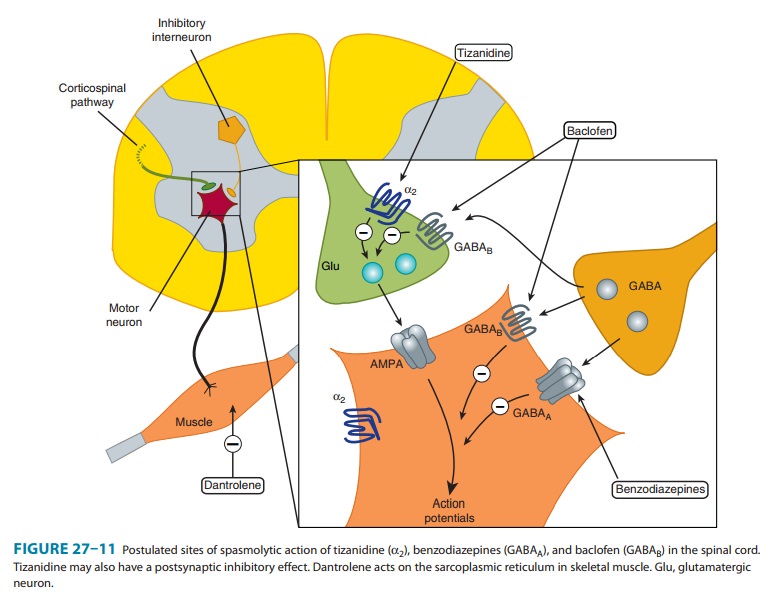Chapter: Basic & Clinical Pharmacology : Skeletal Muscle Relaxants
Baclofen
BACLOFEN
Baclofen
(p-chlorophenyl-GABA) was designed to
be an orally active GABA-mimetic agent and is an agonist at GABAB
receptors. Activation of these receptors by baclofen results in
hyperpolarization, probably by increased K+ conductance (see
Figure 24–2). It has been suggested that hyperpolarization causes presynaptic
inhibition by reducing calcium influx (Figure 27–11) and reduces the release of
excitatory transmitters in both the brain and the spinal cord. Baclofen may also
reduce pain in patients with spasticity, perhaps by inhibiting the release of
substance P (neurokinin-1) in the spinal cord.

Baclofen
is at least as effective as diazepam in reducing spas-ticity and causes less
sedation. In addition, baclofen does not reduce overall muscle strength as much
as dantrolene. It is rap-idly and completely absorbed after oral administration
and has a plasma half-life of 3–4 hours. Dosage is started at 15 mg twice
daily, increasing as tolerated to 100 mg daily. Adverse effects of this drug
include drowsiness; however, patients become tolerant to the sedative effect
with chronic administration. Increased seizure activity has been reported in
epileptic patients. Therefore, withdrawal from baclofen must be done very
slowly.

Studies
have confirmed that intrathecal administration of baclofen can control severe
spasticity and muscle pain that is not responsive to medication by other routes
of administration. Owing to the poor egress of baclofen from the spinal cord,
peripheral symptoms are rare. Therefore, higher central concentrations of the
drug may be tolerated. Partial tolerance to the effect of the drug may occur
after several months of therapy, but can be overcome by upward dosage
adjust-ments to maintain the beneficial effect. Excessive somnolence,
respira-tory depression, and even coma have been described. Although a major
disadvantage of this therapeutic approach is the difficulty of maintaining the
drug delivery catheter in the subarachnoid space, risking an acute withdrawal
syndrome upon treatment interruption, long-term intrathecal baclofen therapy
can improve the quality of life for patients with severe spastic disorders.Oral
baclofen has been studied in several other medical condi-tions, including
patients with intractable low back pain. Preliminary studies suggest that it
may also be effective in reducing craving in recovering alcoholics . Finally,
it has been alleged to be effective in preventing migraine headaches in some
patients.
Related Topics